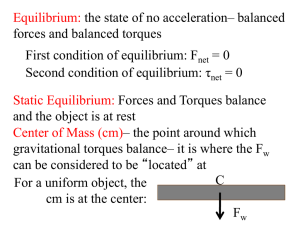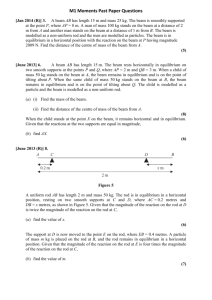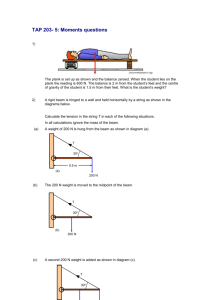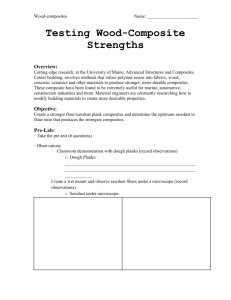questions
advertisement
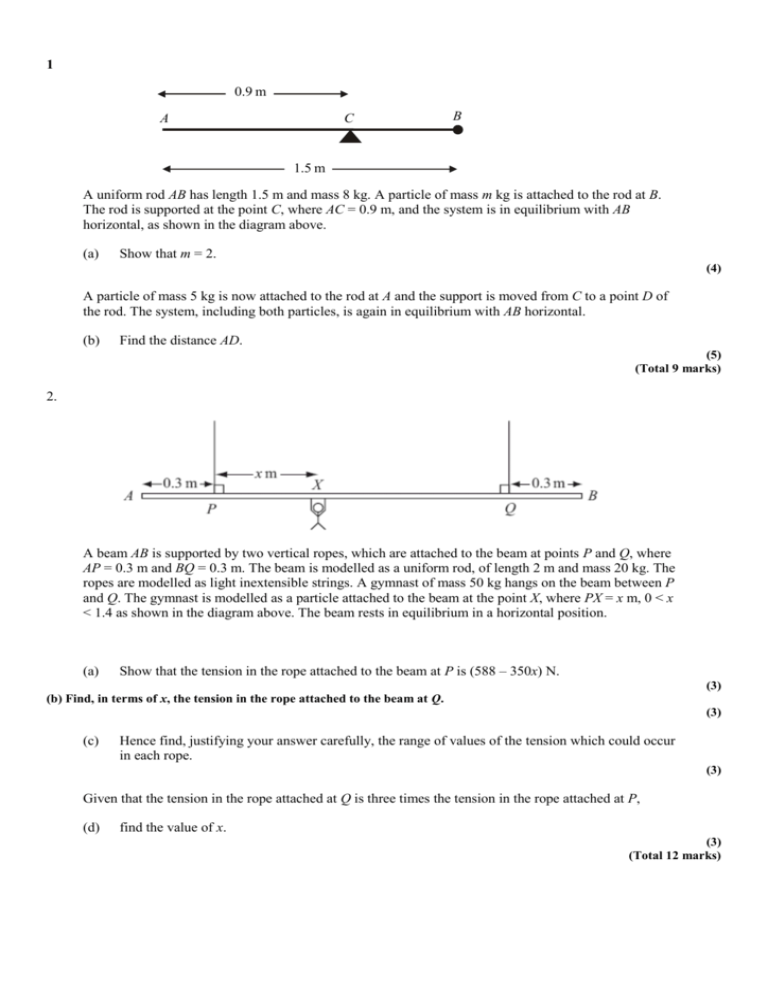
1 0.9 m C A B 1.5 m A uniform rod AB has length 1.5 m and mass 8 kg. A particle of mass m kg is attached to the rod at B. The rod is supported at the point C, where AC = 0.9 m, and the system is in equilibrium with AB horizontal, as shown in the diagram above. (a) Show that m = 2. (4) A particle of mass 5 kg is now attached to the rod at A and the support is moved from C to a point D of the rod. The system, including both particles, is again in equilibrium with AB horizontal. (b) Find the distance AD. (5) (Total 9 marks) 2. A beam AB is supported by two vertical ropes, which are attached to the beam at points P and Q, where AP = 0.3 m and BQ = 0.3 m. The beam is modelled as a uniform rod, of length 2 m and mass 20 kg. The ropes are modelled as light inextensible strings. A gymnast of mass 50 kg hangs on the beam between P and Q. The gymnast is modelled as a particle attached to the beam at the point X, where PX = x m, 0 < x < 1.4 as shown in the diagram above. The beam rests in equilibrium in a horizontal position. (a) Show that the tension in the rope attached to the beam at P is (588 – 350x) N. (3) (b) Find, in terms of x, the tension in the rope attached to the beam at Q. (3) (c) Hence find, justifying your answer carefully, the range of values of the tension which could occur in each rope. (3) Given that the tension in the rope attached at Q is three times the tension in the rope attached at P, (d) find the value of x. (3) (Total 12 marks) 3. A bench consists of a plank which is resting in a horizontal position on two thin vertical legs. The plank is modelled as a uniform rod PS of length 2.4 m and mass 20 kg. The legs at Q and R are 0.4 m from each end of the plank, as shown in the diagram above. Two pupils, Arthur and Beatrice, sit on the plank. Arthur has mass 60 kg and sits at the middle of the plank and Beatrice has mass 40 kg and sits at the end P. The plank remains horizontal and in equilibrium. By modelling the pupils as particles, find (a) the magnitude of the normal reaction between the plank and the leg at Q and the magnitude of the normal reaction between the plank and the leg at R. (7) Beatrice stays sitting at P but Arthur now moves and sits on the plank at the point X. Given that the plank remains horizontal and in equilibrium, and that the magnitude of the normal reaction between the plank and the leg at Q is now twice the magnitude of the normal reaction between the plank and the leg at R, (b) find the distance QX. (6) (Total 13 marks) 4 A C B 1m 3m A uniform beam AB has mass 12 kg and length 3 m. The beam rests in equilibrium in a horizontal position, resting on two smooth supports. One support is at end A, the other at a point C on the beam, where BC = 1 m, as shown in the diagram. The beam is modelled as a uniform rod. (a) Find the reaction on the beam at C. (3) A woman of mass 48 kg stands on the beam at the point D. The beam remains in equilibrium. The reactions on the beam at A and C are now equal. (b) Find the distance AD. (7) (Total 10 marks)

